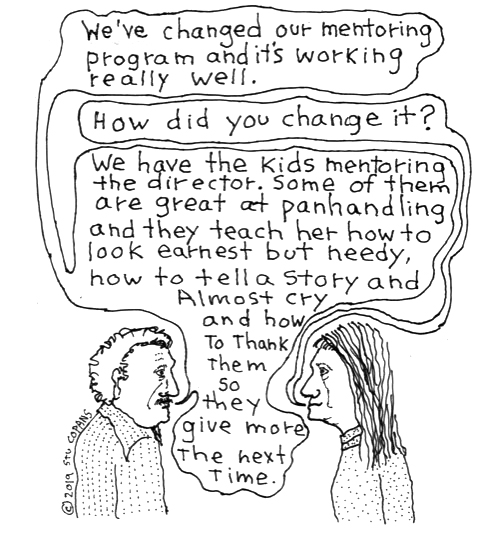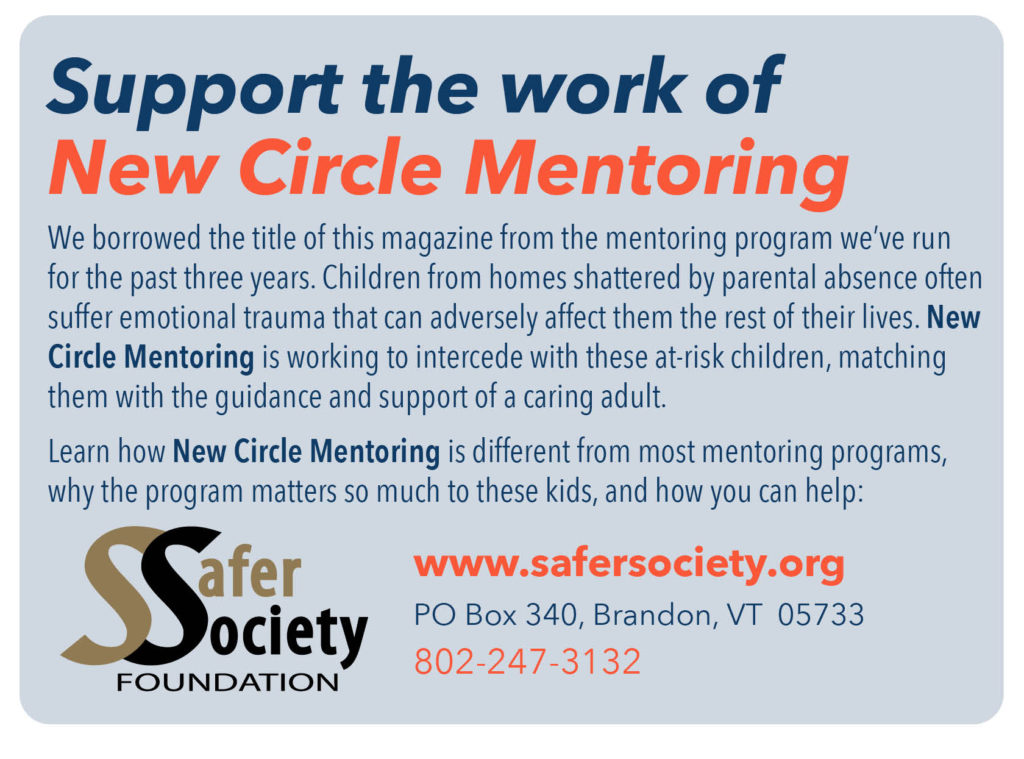Mentoring is Hard—Mentoring At-Risk Youths is Harder
By Mary Falcon, Safer Society Executive Director
Organized youth mentoring programs are a relatively new phenomenon in the United States. Programs focusing on the more difficult task of mentoring at-risk youngsters are an even newer phenomenon. Because at-risk mentees have greater needs than other mentees, mentoring them successfully requires a higher level of mentor training, supervision, and support in addition to a variety of wrap-around services. For these reasons, at-risk mentoring programs have higher implementation costs than general youth mentoring programs. Unfortunately, funding sources have yet to recognize the difference between the two types of programs.
A Brief History of Organized Youth Mentoring
Whereas other governmental and non-governmental helping organizations—child and family services, school counseling, family therapy, family courts, etc.—have been around since the early 20th century, mentoring as an organized service for children and adolescents did not take off in the US until the late 1990s. Up until then, Informal mentoring of a youth consisted of emotional support and guidance from an older family member, athletic coach, teacher, clergyman or den leader. The only formal youth mentoring going on was Big Brothers Big Sisters, which had been around since 1904.

Formal youth mentoring remained almost exclusively a service of BBBS-affiliated programs until research released in the 1990s documented the effectiveness of the BBBS model. The result was an explosion of interest in youth mentoring and the steady growth of such programs throughout the US.1 Since then, both governmental and nongovernmental funding has risen into the millions of dollars a year.

Major Challenges of Youth Mentoring Programs
In 2016, the National Mentoring Partnership conducted a survey that examined 1,451 mentoring programs across America.2 Of the challenges reported by the respondents to this survey, the two most common were the recruitment and retention of mentors and fundraising. Mentoring programs that specifically serve high-risk youths face even greater mentor retention and funding challenges than general youth mentoring programs. In addition, they face a third challenge not faced by ordinary mentoring programs—the need to supplement the mentoring relationship with wrap-around services for the mentee, the family, and the guardian.
The Challenge of Mentor Recruitment and Retention
No matter where you look in this country, there is no dearth of at-risk children and adolescents who have been referred to mentoring programs by parents, school counselors, or child and family services. The challenge for all mentoring programs is to find caring responsible adults who are willing to commit to mentoring a young person for a given length of time, are able to pass a rigorous background check, and do not quit before their time commitment is up. But while most mentoring programs for the general population of youngsters require a minimum commitment of one year, programs for at-risk youths must demand a minimum three-year commitment and therefore must screen mentoring candidates much more rigorously, train new mentors much more thoroughly, and provide them with much more supervision and support throughout the length of their commitment.

Because the central component of mentoring is the formation of close relationships, the length of mentoring relationships is one of the most important indicators of positive change in youths. Many investigations have highlighted the importance of mentor/mentee match length and consistency, as well as the negative consequences of early terminations.3

In the year before Safer Society Foundation launched its mentoring program for at-risk children in Vermont, we attended a variety of live and online mentoring forums and spoke with the directors of the larger mentoring programs in our state. One of the main lessons learned was that mentor retention is a more formidable task than mentor recruitment. A number of directors I spoke with told me that up to 50 percent of their mentor recruitment time was spent replacing mentors who had drop out of the program prematurely. Early termination is indeed the scourge of mentoring programs. I was determined to make our program as dropout-proof as possible. The mentoring article in the second issue of The New Circle will describe the steps Safer Society Foundation has taken to achieve this goal.
The Challenge of Fundraising
Most mentoring program funding comes from governmental and private grants. In general, there are three primary criteria for both types of grant awards:
• Program size, i.e., the number of mentor-mentee matches.
• Program growth, i.e., net new matches per funding year. According to Mentor Vermont, “programs that are able to sustainably grow their program to reach more youths may receive a larger grant award.”4
• Program sustainability, i.e., evidence that the program can sustain itself financially—the best evidence being program longevity and a history of program funding.
For at-risk youth mentoring programs, the criteria set by funding sources are doubly challenging to meet. For starters, the size of any youth mentoring program startup is, by definition, small. All start-up programs have difficulty competing for funding with established programs that have high numbers of matches and low per-match costs. Because programs dedicated to at-risk youths need to have a complete support infrastructure in place at the start, high numbers of matches and low per-match costs are not achievable goals at any point in time, much less at startup.

Secondly, rapid program growth is anathema to programs for atrisk youths. Directors of mentoring programs seeking to increase their match numbers to meet the goals of expansion set out by mentoring funders find themselves in a vicious cycle of rapidly recruiting and training new mentors; losing a large percentage of them prematurely; then needing to recruit and train new mentors just to replace the dropouts. This cycle of mentor turnover is especially harmful to programs in which the single most important goal is to provide long-term, reliable mentoring relationships to at-risk youths.
Finally, the requirement of financial sustainability set by funding sources means, quite simply, that you need to have funding in order to secure funding. Most startup programs have neither. As the director of Mentor Vermont, a key distributor of governmental and nongovernmental mentoring program grant money in the state of Vermont, told me recently, those funding sources are just beginning to consider quality as well as quantity in their criteria for determining grant awards. If that is so, it represents a giant step forward in the battle to adequately fund mentoring programs for at-risk children and adolescents.
The Challenge of Providing Wrap-Around Services
The findings from a 2017 research study funded by the US Department of Justice suggest that while high-risk youths stand to greatly benefit from being in a mentoring relationship, their high-risk status also poses a greater challenge to mentoring programs.5 As mentioned earlier, it is critically important that programs serving high-risk youths selectively recruit mentors whose backgrounds and circumstances attest to their ability to cope with the challenge and provide them with high-quality pre-match training as well as ongoing supervision and support from agency staff.6 In addition, programs that focus on high-risk youths face the additional challenge of providing wrap-around services to mentees, their families, and their guardians through partnerships with the local schools, the mental health counseling agencies in the community, as well as the state and local child and family services and foster care providers.
In the mentoring article in the second issue of The New Circle, we will describe the successful partnership between the Counseling Service of Addison County, Vermont, and Safer Society Foundation’s mentoring program. In future issues of The New Circle, articles in this column will examine other innovative solutions to the challenges faced by at-risk youth mentoring programs such as:
• Identifying and recruiting the best mentors
• Training mentors of at-risk youths
• Building community connections of mentees through group activities
• Successful partnering with school counselors and school-based clinicians
• Fundraising within the community
• Applying for grants
- Big Brothers Big Sisters. Who we are. http://www.bbbsi.org/about-us/
- Mentoring.org. (2017). Mentor survey report. https://www.mentoring.org/new-site/wp-content/uploads/2017/07/
- Rhodes, J. (2017, April 26). What can data from 6,500 matches tell us about mentoring relationships?: Important insights from a new study. The Chronicle of Evidence-Based Mentoring. https://www.evidencebasedmentoring.org/can6500-matches-tell-us-mentoring-relationships-important-insights-new-study/
- Mentor VT. (2018). 2017-2018 Vermont mentoring grants. https://www. mentorvt.org/vermont-mentoring-grants/2017-2018/
- Office of Juvenile Justice and Delinquency Prevention (2017, November). Mentee risk status and mentoring program practices predictors of match outcomes: OJJDP-funded research in brief. U.S. Department of Justice. https://www.ncjrs.gov/pdffiles1/ojjdp/grants/251393.pdf
- Jarjoura, G. Roger. (2016, February 14). Mentoring for children of incarcerated parents: National Mentoring Research Center review. The Chronicle of Evidence-Based Mentoring. https://www.evidencebasedmentoring.org/mentoring-for-children-of-incarcerated-parents-national-mentoring-resourcecenter-review/

Mary Falcon
Mary considers the New Circle Mentoring program and The New Circle magazine her two greatest accomplishments as executive director of Safer Society Foundation, a position she has held since 2014. Except for the two years she spent overseas at a US Army base teaching adult education, her entire professional career has been in book publishing, from marketing to book acquisitions and development at Random House, Harper Collins, Houghton Mifflin Company, and Safer Society Press. Although she quit New York City life 18 years ago to live in rural Vermont, her language has been known to revert to its Bronx roots when she gets riled up.



